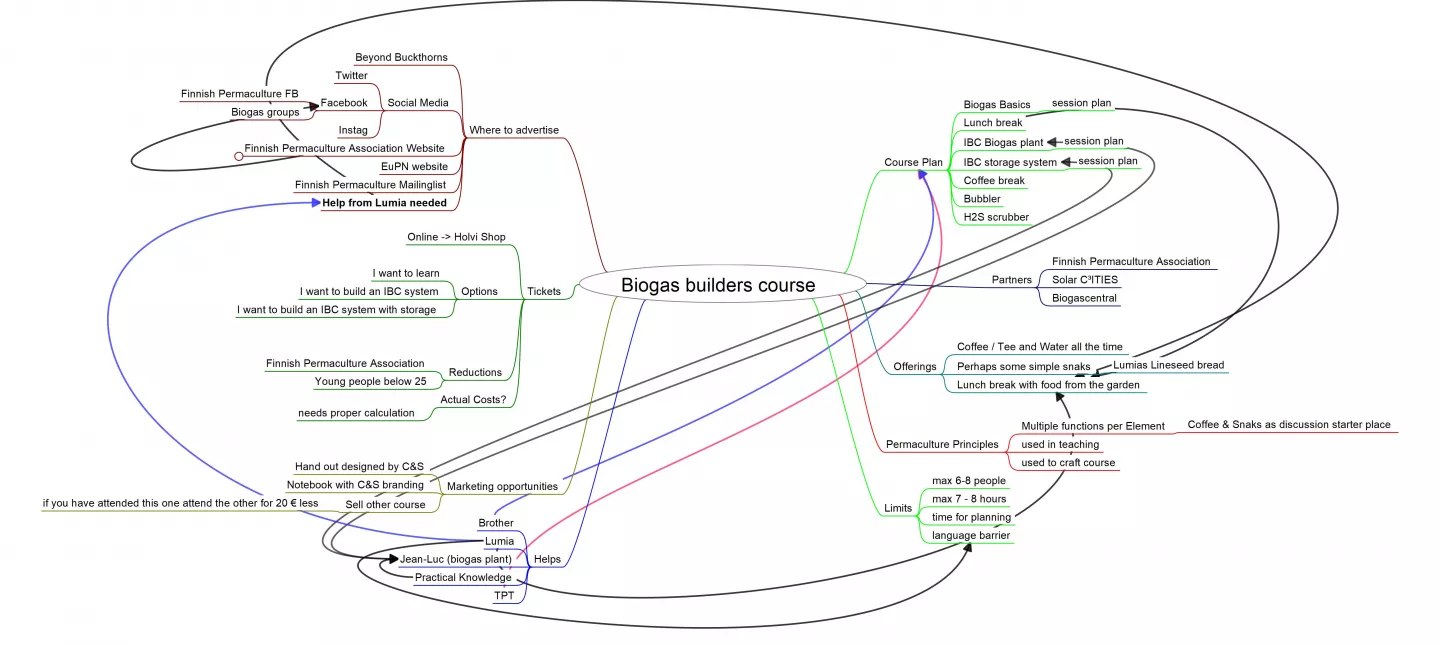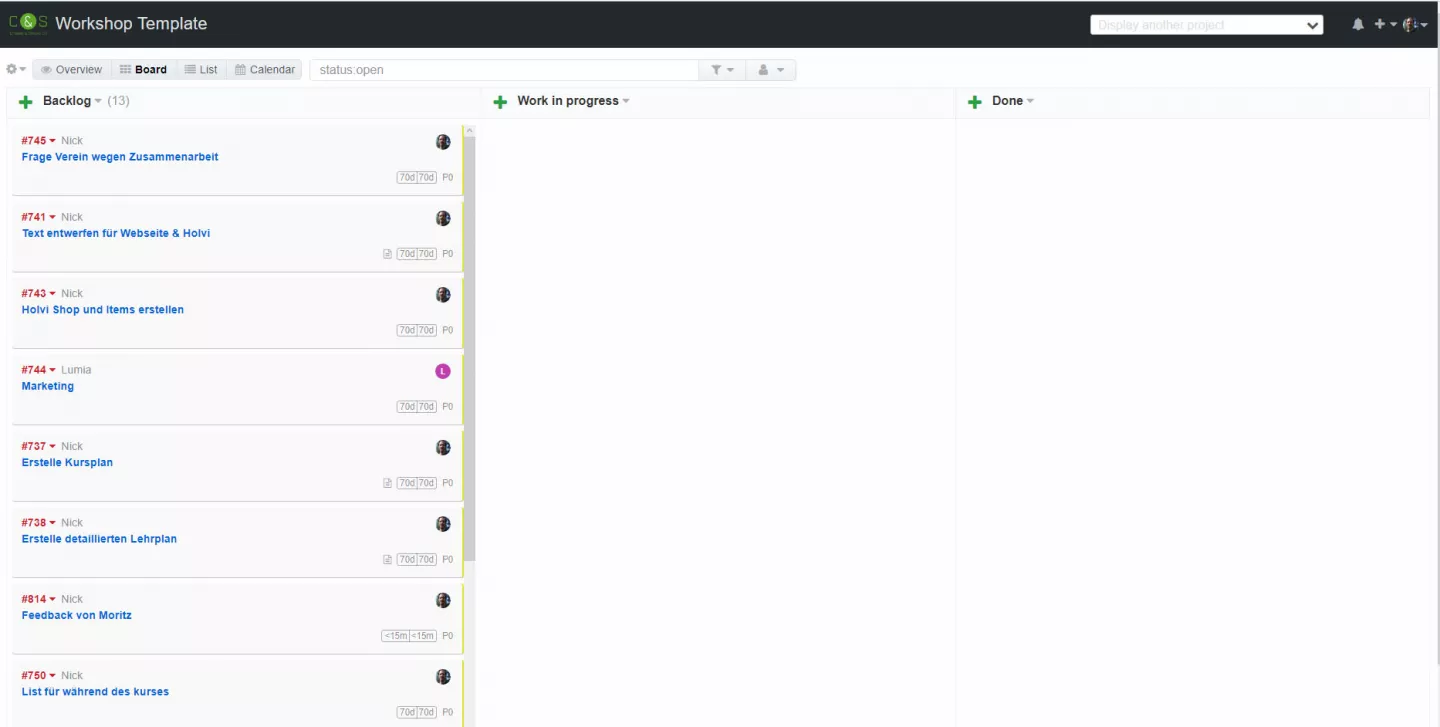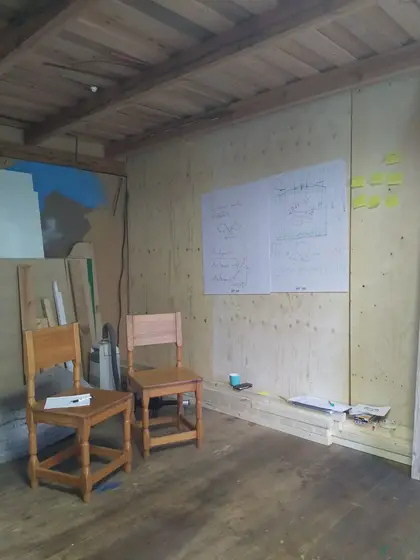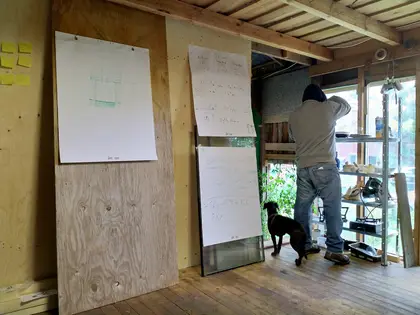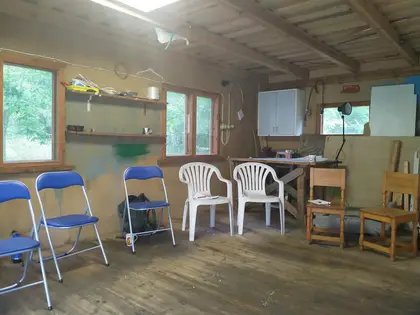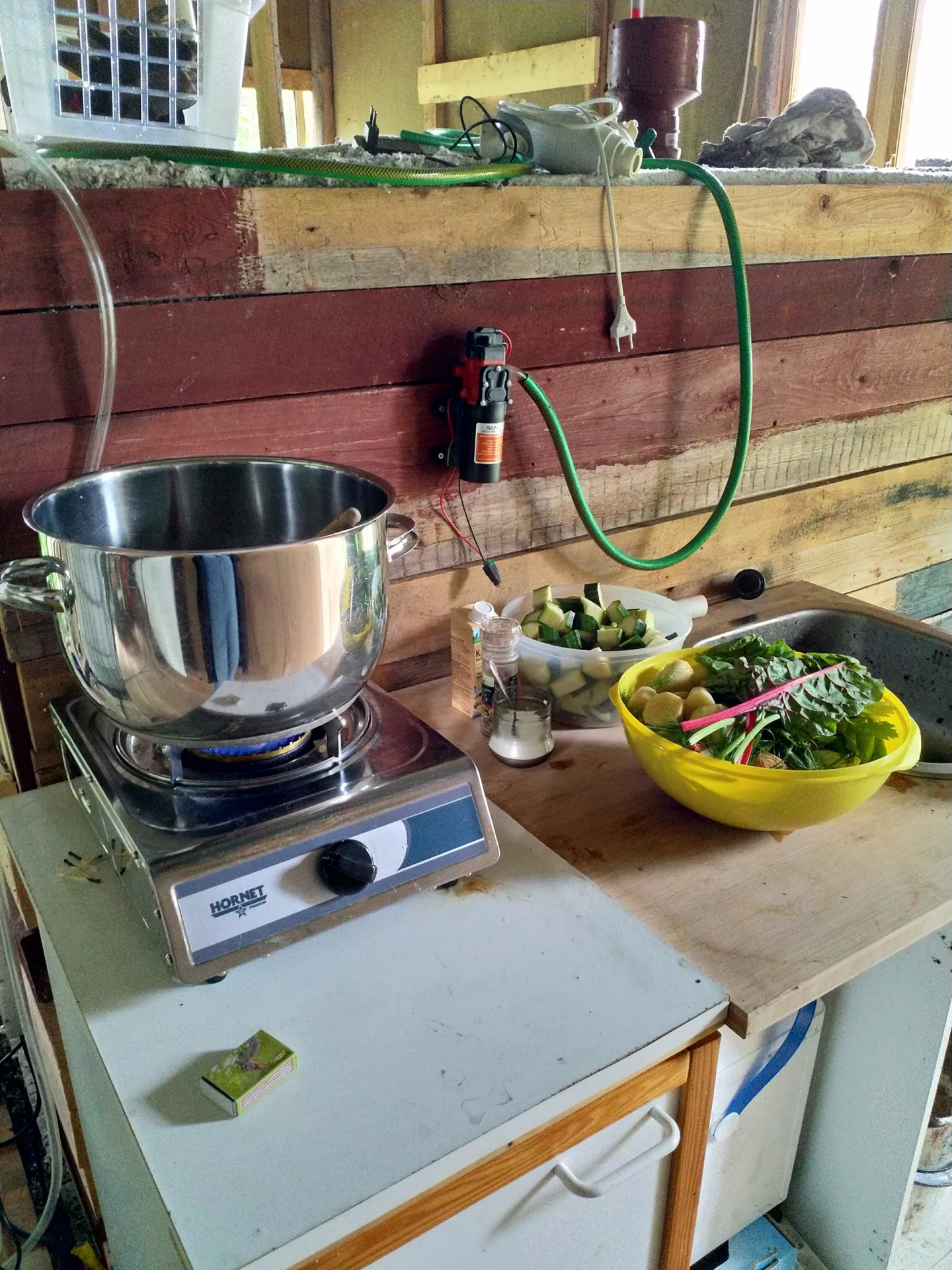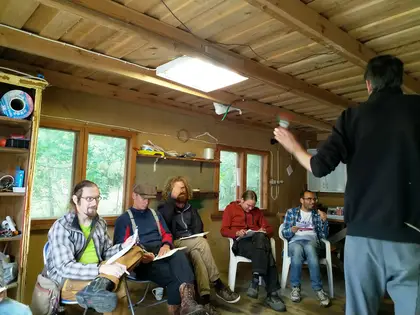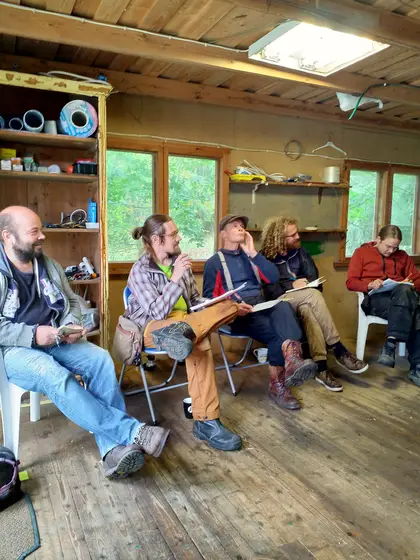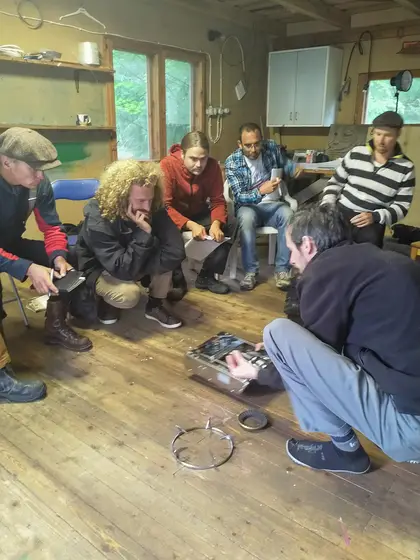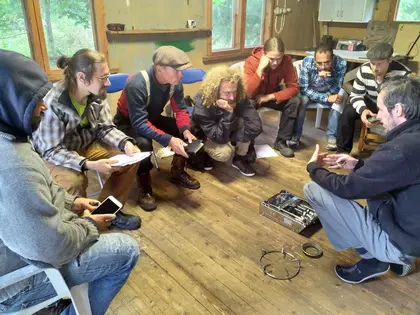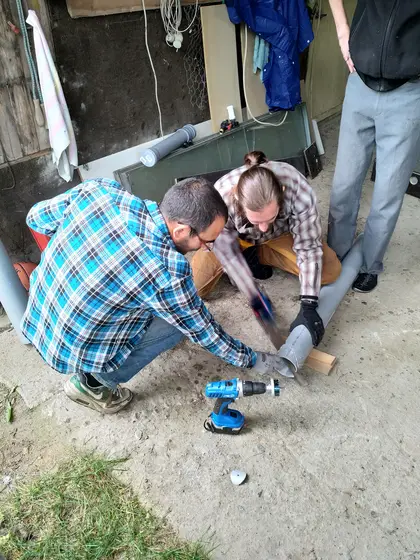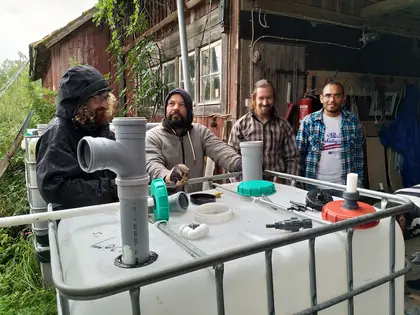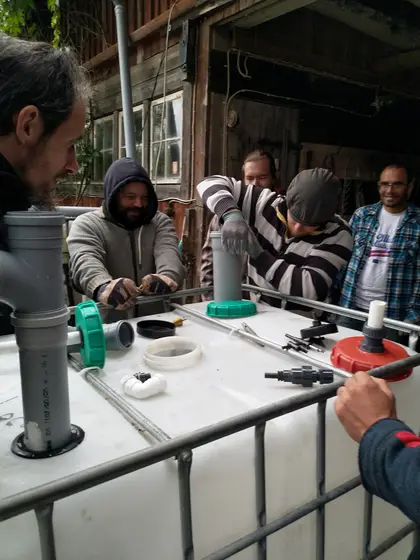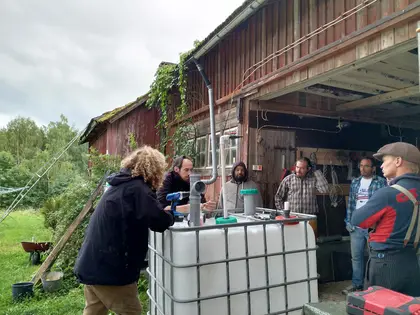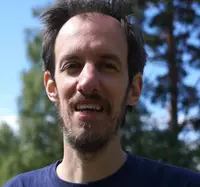Preface
I have a biogas plant, whom I call “Jean Luc”, since October / November 2019 I can showcase it. But just showcasing it is not enough for me. For sure is it nice to let friends cook pancakes on biogas or grill some vegan sausages but that doesn't transport all the knowledge necessary for others to build their own plant. It is not about me having one biogas plant - it is about the hundreds of thousands of people who could have their own biogas plants going. And if you have ever been given the entire power of a blue infinity stone (or if you want so – the power of the blue flame) you have been given enormous powers.
Goals
The goals in accordance with the permaculture ethics as follows:
Earth Care: Demonstrate the full cycle of biogas production. Come for the gas stay for the effluent. Cooking demonstration on biogas, feeding the dragon with food scraps.
People Care: teach and empower people; Make all the participants feel welcome and that their input is of value for the project.
Fair Share: food from the garden, feedback and ideas from the participants
Since it is a social design I opt for Looby's web. Getting more experience using it helps me to become better, and even better in social design.
Vision
Building a blueprint that allows me to teach about Biogas in particular but other topics as well.
Helps
Identifying helps is not always that easy.
- Family, especially my brother
- An existing biogas plant that is up and running
- Practical knowledge in running a biogas plant
- Build several plants over years
- The TPT course in Bulgaria, knowledge how to teach
- Already held 3 practical biogas workshops before
- held 2 "Introduction to biogas" courses before
Limits
- Amount of persons that can be hosted at Beyond Buckthorns – at the moment 6-10
- Time the course can run (not more than 1 day)
- Money to buy the parts needed
- Time available for planning
- Amount of people that can be hosted for a workshop during rain / difficult weather conditions
- Language barrier
- Food in the garden at the time of course
- Course fee
Mindmap
I also created a mind-map to get an overview of the different aspects. The mind map shows a lot more than just limits and helps. It gives an overview of everything I had thought of while creating the course.
Action
Let’s analyses what I got.
SWOC
Evaluating the data at hand and putting it into a SWOC analysis
| Strength | Weakness |
| proficiency with Biogas | going to deep into topic |
| practical knowledge | misunderstanding the level of knowledge of participants |
| Marketing | having own knowledge gaps |
| Practical Teaching experience | sometimes getting stuck |
| Permaculture design experience | |
| Opportunity | Challenge |
| combining biogas with Permaculture | language barrier |
| serving food from the garden | setting expectations right |
| Cross-advertising other courses | finding participants |
| Showing the homestead | price point of the course |
| getting people interested in DIY energy production | the weather |
| getting people interested in DIY in general |
For me it seems that are are a lot of opportunities there but also challenges.
Patterns
One of the negative patterns is that I usually sabotage myself if sign-ups to an event do not start happening fast. I lose interest in holding the course. I have a personal threshold that kind of needs to be fulfilled. It's like a personal goal that determines success. I really should overcome that negative pattern and make sure that success is more about the quality of the teaching and transporting the information and learning from what I'm doing than about how many people come to the course. TH once said that I'm a pretty good teacher. Let's prove that.
Another negative pattern comes from holding courses at Beyondbuckthorns. It also means showing the project itself which I'm in its current stage uncomfortable with. And due to that I actually want not that many people participating. I kind of sabotage myself again. It is like someone tells me constantly that this not good enough.
Since I'm on the countryside and I'm not that fluent in Finnish (intensive Finnish learning will start after the diploma) I have started to isolate myself more and more. Courses are something that help me to connect with people.
A positive pattern is that this is part of the diploma process and I'll take another approach than usual. It is kind of a totally different view of perspective and how the course gets constructed. Much more thoughtful.
Principles
In this design the following principles will guide the design:
- Multiple elements for important functions -> A course opens another income stream, if the weather is good we are outside, if its bad we are inside.
- Multiple functions per element -> A course is dissemination of knowledge while earning money and making new contacts, Lumia is taking care of food but also could help with translation
- Edge effects -> there will be participants that are not affiliated with permaculture, this also is true for diversity
- Use Biological resources -> Food from the garden, cooking with the endless power of the blue flame – the energy of the sun
- design from pattern to detail -> course timetable -> session plan
Action
Before we start I needed to have some questions answered:
What will the biogas workshop mainly be about?
- Giving a very good introduction in the biogas theory
- Building an IBC based Biogas plant and an IBC based hydraulic storage system
- Practical knowledge of running a biogas plant by examples from my biogas plant
What should a participant at the end have learned?
- Biogas theory: what is biogas, how is it produced, who is producing it? - we are dealing with living creatures, biodiversity is key
- Digester building: what are the essentials parts of a biogas plant, why is it build in that way?
- Practical knowledge: what are simple remedies for problems, how to modify a gas stove, how to store gas?
I should address my challenges found in the SWOC and think of how to overcome them
- Language barrier
- course is advertised in English only
- offer translation if needed
- Setting expectations right
- the course advertisement and the course plan are precise and double checked
- Explain in the beginning what participants will learn
- Ask for expectations from the participants
- Finding participants
- Handed over to Lumia as she has access to far more groups than I do
- Price point of the course
- Checking specialist courses / workshops prices first. For example Erkki’s bee keeping course in 2019 (60 €) or Philipp Weiss’s 2 day food forest course (250 €). Both come with food. A two day “Introduction to Permaculture” cost 110 € in 2019. Let’s take the average: (250/2 + 60 + 110)/3 = 98,33 €, which I think is too much for the course. I go in between the introduction- and the beekeeping course and settle for 85,- € - and add some reduction for early birds and those that are member of the Finnish Permaculture Association.
- The Weather
- Should actually be no challenge at all after the upgrade of the Biogas shed so that it can be used as teaching space.
I should address my weaknesses identified in the SWOC and design something to address them:
- Let's start with first writing a course plan. The course plan will be the guide through the day.
- Once the course plan is ready we can create a more detailed lecture plan.
- Send the course and lecture plan to my brother and let him make suggestions
- The lecture plan should make sure that we mention permaculture and why we have created the biogas shed and the “Jean Luc” in a particular way
- Read the notes from the last lectures and this time evaluate and debrief afterwards (needs debriefer)
This should help me to not get stuck, and not to go to deep into a topic. For the knowledge gaps I have to open some books and some wikipedia pages. I know which one. Just takes some study time.
In order to get the word out that there is a course:
- Check with the Finnish Permaculture Association if the course will be featured / co-hosted by them
- Set up a Holvi (Finnish web store) store item + a discount item for members of the Finnish Permaculture Association
- Create an advertisement for the course that can be subject to change.
- Publish the course in different channels
- Publish the course plan 2 weeks before
- Send the course plan 2 days before the course to the participants
Before the course:
- Check with Lumia to see what will be ripe in the garden during the course.
- Get some of the biogas sheds tasks done so we have a space for about 8 people (additional) otherwise use the garage (14 people max) → this idea will change another design
- buy and source all necessary parts in time (buy the IBCs close by)
- prepare the place where the storage system will be placed after creation
During the course:
- bottomless coffee / tee / water during the course
- make sure everyone is comfortable
- answer questions right away
- let the group decide what they want to explore -> design the lecture plan with it in mind
- Blue flame power!
- Showing the food forest and parts of the estate
- Serving food from the garden!
After the course:
- evaluation including debrief and appraisal (appraisal and debrief could be done by Lumia)
- feedback from the participants
- what was best?
- what was worst?
- what would you change?
Once we have all the necessary parts in place create an implementation plan and put the parts onto a Kanban (project management tool). A Kanban is used in SCRUM, which comes from software development. Basically a Kanban is a far better way of managing agile projects than for example a gantt chart. Kanban is flexible but needs proper handling. Most permaculture projects I were part of had no clue how a Kanban really worked. From my perspective a Kanban is a proper design tool that is used during the implementation phase – in my case extensively.
Since I wrote in the beginning that I want this design to be a blueprint for other workshops I created a template for workshops in the Kanban tool. I can now, when I plan a workshop, just copy the template and have a structure of items that are the same for every workshop. Good, or? Work smart not hard!
Principles
Let them run again. This time against the workshop’s session plan.
Multiple elements for important functions: Using different techniques to teach: drawings, words, questions, quizzes, symbols, games, participation, etc.
Use edge effects: Integrate permaculture topics, like zones into the teaching. Talk about topics that are on the edge of or within permaculture like for example bio-char, rocket stoves, solar vacuum tubes etc.
Implementation
1st stage of implementation.
- Asked the Finnish Permaculture if it is OK to partner.
- created the Holvi store items with an additional 10% discount for association members.
- created text and Lumia rewrote it
- advertisement at different websites, social media according to Lumias social media marketing plan
- bought all the IBCs (and some more – since they are needed for other tasks)
- checked all the material necessary for building
- feed the dragon in order to gain blue flame power
Pause
For some time I didn't really work on the workshop. There was simply no time and other designs were more pressing, for example that for the association's communication design and the PermaCafé. I also had to deliver a presentation for the association's summer meeting.
Implementation
2nd stage – creating plans, details
- course plan
- session plans
- check the materials used (is there a flip chart?)
- step through the course and session plan again (quality check)
- list "what has to happen during the course"
- Check if there is enough blue flame power available
Course plan:
| Biogas Workshop day schedule | V0.98 | ||
| Start | End | Subject | Duration |
| 10:00:00 | 10:30:00 | Grab & coffee and introduction round | 00:30:00 |
| 10:30:00 | 10:40:00 | Explain schedule of the day | 00:10:00 |
| 10:40:00 | 11:50:00 | Biogas theory | 01:10:00 |
| 11:50:00 | 12:35:00 | Launch break | 00:45:00 |
| 12:35:00 | 13:50:00 | Biogas theory part 2 | 01:15:00 |
| 13:50:00 | 15:00:00 | IBC biogas system | 01:10:00 |
| 15:00:00 | 15:15:00 | Coffee | 00:15:00 |
| 15:15:00 | 16:00:00 | IBC storage system | 00:45:00 |
| 16:00:00 | 16:30:00 | Installation of the storage system | 00:30:00 |
| 16:30:00 | 17:00:00 | Practical tips, modifying gas stoves, Q&A | 00:30:00 |
| Total | 07:00:00 | ||
Session plan of one session:
| Biogas Workshop v0.98 | |||||
| Session Title | Biogas 101 | ||||
| Learning objectives | Understand the theory of biogas, how it is produced, from what is it produced, stages of production, who produces it | ||||
| Resources needed | Board to draw on, flip-chart or canvas, etc. | ||||
| Session Plan | |||||
| Activity | Time | Coach | Method | ||
| Sitting tree | 2 | Introduce the sitting tree and hand out markers | |||
| Expectations | 2 | Let everyone write expectation on a post it and then put them on the wall | |||
| See for yourself | 20 | Split them into two groups | observation | ||
| Group 1: draw human digestion | Group 2: watch Jean-Luc | interaction, group work | ||||
| 5 | Compare the two drawing, describe the process | deduction | |||
| The black-box | 10 | draw an empty Box and ask for the findings | |||
| 10 | Can you imagine how it looks inside? Why does it look so inside? | discussion | |||
| Kingdoms of MO | 5 | What kind of Micro Organisms do you know? | Group work / search at google Micro Organism kingdom → tablet | ||
| 5 | Introducing the Archea & Methanogens | ||||
| A new world | 10 | the Methanogens in details - what do they need in order to live? - explain environmental variables? - explain that the human body is actually a pretty good place for them | |||
| Sum | 69 min | ||||
After the first design of the schedule and the session plan I sent the files to my brother and then called him for consultancy. I switched some of the activities around and integrated more interactive elements which he suggested. It is really helpful when it comes to teaching and social skills to have someone like him. While I’m the older brother he is on that part the wiser. It is nice to see how a younger generation does really important work, and not just travel to an Ashram in India once or twice a year because they think that is part of a permaculture lifestyle and their ego is dictating them to do so. How is traveling to get the Zone 00 in order Earth Care?
The practical part of the course / workshop also needed preparation. The week before the course I set up all the parts needed, cleaned out the IBC’s (the molasses form the IBC’s cleaning is fed to Jean-Luc) and made sure all tools needed were in good condition and working. For those who wanted to get hands-on experience we handed out gloves.
The biogas shed design implementation was driven forward and I changed it in order to fit enough people during rainy weather into the shed.
Corona made additional precautions necessary. For washing hands we mixed rain water with ash to create a lye. I checked the pH with litmus paper.
Momentum
I kept the momentum up nearly all the time. As described in patterns I had some problem with the low subscription rate in the beginning but the positive pattern of creating a proper design for the diploma kept me going. After all biogas is something mysterious that needs more demystification.
Action
Just because a workshop is over doesn't mean that there isn't stuff around that needs to get done
- Sending out an e-mail with links to all participants
- Check for feedback → create a feedback form
- Following up business opportunities → this could be another design
- Feeding the participant’s poo to the dragon
Reflection
As always I use the WBC (worst, best, change) analysis. I split this into 3 parts. Unfortunately I couldn’t get any written feedback from the participants. I have to find another way for the next course how to get feedback. Perhaps handing out a feedback form in the beginning.
Lumia's reflection
Lumia was responsible for marketing before and for catering during the event.
What was worst?
Not being able to participate much in the course.
What was best?
Demonstrating biogas cooking! The people. Being able to show Beyond Buckthorns to people.
What would you change?
I hope Nick can work on his negative patterns he mentions a bit. Not mentioned above are the countless moments of me keeping the momentum up and pushing through when he wanted to toss the whole course. That is a lot of work and life energy that goes largely unnoticed in this design.
My reflection
What was worst?
Me having difficulty to explain physical and chemical fundamentals to someone with a non-technical background, for example a musician. I haven’t asked for name tags in the beginning. I can’t remember names and I need name tags.
What was best?
Showcasing a permaculture design that actually works, the biogas shed, and of course showcasing "Jean Luc". Lumia cooked our lunch with biogas so that the participants can see the difference between a full bag of gas and a gas after 1 hour cooking.
I also liked to go with the flow of questions. Sometimes the participants took the next chapter of the lecture plan ahead. It was kind of fun to see that most of the details worked. Lumia’s cake and self made humus was so delicious. And, of course the participants. I learned a lot from them.
Transforming the biogas shed design so that one part of it can be come a class room. Without that workshop I would have never thought of that.
I now have this Kanban template!!!
What would you change?
The preparation of the practical part wasn't that good. I had to run around for some tools. Took me 10 minutes to get everything together.
Next time it would be much better if could show how compression works and how to generate electricity. From the money earned from the workshop I will dive into those two.
I should mention the Finnish Permaculture Association as a partner. Totally forgot it. Sorry. :(
A clock in the room so that I can speed up if I fall behind schedule. I have to get familiar with other gases. I never thought about using Propane and Butane. It feels and always felt so unnatural, yet people using it constantly (the usage of propane is on the rise – even in the permaculture community, especially ecovillages). So the additional info of those gases will be useful. So, what would I change? Perhaps more enthusiasm, learning more about where people come from to biogas.
Due to the constrains from the diploma, my work and the work with the Finnish Permaculture Association I constantly feel energy depleted and enthusiasm or happiness isn’t that easy to come by anymore. But that’s a different design.
Achieving the goals set in the beginning
Earth Care: Afterwards I fed the food scraps from the launch to the digester. I also fed the participant’s poo to the digester – after waiting 2 weeks of course. The effluent got mixed with saw dust and hemp and then distributed in the garden – back were the food for the workshop came from.
In terms of Earth Care more could have been done. Showing the mixing of the effluent with the bio-char might make a difference. But, bio-char was a topic during the discussion and I explained the process.
People Care: I think everyone felt welcome at the event. All the expectations that were put up by the participants in the beginning were met. Many participants stayed longer and I answered further questions.
Fair Share: I got some interesting ideas I’m already working on.
[UPDATE] Reflection about the design web
For some designs I have used Looby’s design web now. My only trouble was how to fit the Obredim process’s evaluation step into it. The question for me always was: “Where is the evaluation done”? Is it the anchor point action? Or is it limits? For myself I have decided to use evaluation wherever it is appropriate. I think I can use evaluation in helps, I can use it in limits to evaluate limits, etc. Basically nearly every anchor point allows evaluation and if not the anchor action can be used for evaluation. That's my take on it.
From my perspective Looby’s design web is a more natural process. Compared to Obredim, which is kind of rigid, the design web allows adaption to the designers needs, or actually to the outcomes needs. What helped me in this particular design is stepping for example through the patterns twice, or splitting action and implementation into multiple steps.
Not all of the anchor points were relevant. This time I didn’t step through “ideas” knowingly. But I called my brother for input and now since I’m reflecting on it think that I also used the “ideas” anchor point, because I got a lot of ideas from him.
What really helped this time were the patterns, especially using them twice. Sabotaging myself is a huge issue for me and patterns helped me to think about it and then take action.
Looby’s web will return in another design! For sure! [/UPDATE]
Appreciation
Teaching is fun – always. What I saw during my presentation during the Nordic Institute meeting 2020 in Denmark, that when I start a presentation about biogas that one question after another starts was also the partially the case during this workshop. I went with the flow and framed it into the parts I had on my teaching list. I changed the order around to fit the natural flow of questions. It didn't fully work out as planned but all parts got covered. I highly appreciate being given the opportunity to teach and showcase biogas in Finland. All this wouldn’t be possible without my tutor TH Culhane.
I’m very thankful for Lumia’s help and I’m also very thankful for my brother’s help. Without both the workshop would have been a drier experience.
I also appreciate the teaching from the TPT in Bulgaria. Without it I wouldn’t have been able to unleash the blue flame power effectively and teaching would be like fighting with 2 hands tight behind my back.
Accreditation criteria
I’m using the categories which I have used in the designCamp design.
Demonstrating design skills
- Looby’s Web
- Ethics
- Principles
- BWC
- SWOC
- Mindmap
- Helps & Limits (part of Looby’s web)
- Schedules
- Session plans
- Kanban
- Usage of consulting
Applying permaculture in my own life
This is something I wrote before: Bringing people into my life that I don’t know or people that I know a little and then friends and family is like the entire zone of people is present. It is something I enjoy. Besides that I actually used the “Pause” stage also at the end, which I didn’t describe deliberately, on Monday after the course to do nothing, just chill. For many, not most, decisions I often ask myself: How is that permaculture? How is that earth care, people care, and fair share?
Learning from and developing your permaculture practice
From the biogas workshops that I held before this was the most exciting one. There were two things that came together: First of all it was at Beyond Buckthorns. Second: it was a biogas workshop that got designed with permaculture design. What I learned from the workshop before helped and with more workshop I gain more confidence. What I learned from this one is that I can go with the flow and abandon my session plan as long as I cover the topics I have set to be learned by the participants. It actually feels more natural. But it also has its limits. In order to make the workshop even more edutaining I think I have to gain more experience and think more about the tools used.
I’m not sure if I’m not missing some tools for the evaluation at the very end…
Applying permaculture to my work and projects
Within Holmgrem’s domain this design is of course “Education and Culture”. This workshop helped to generate an income stream that financed part of the biogas shed / “Jean Luc”. Another workshop next year and the system will have already paid itself (of course the years of learning not included). Perhaps not paid by itself but paid for a generator a compressor and some bottles to get compression going.
The might blue flame will return!



